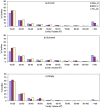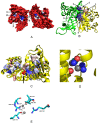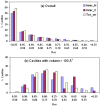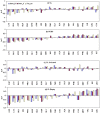Cavities and atomic packing in protein structures and interfaces
- PMID: 19005575
- PMCID: PMC2582456
- DOI: 10.1371/journal.pcbi.1000188
Cavities and atomic packing in protein structures and interfaces
Abstract
A comparative analysis of cavities enclosed in a tertiary structure of proteins and interfaces formed by the interaction of two protein subunits in obligate and non-obligate categories (represented by homodimeric molecules and heterocomplexes, respectively) is presented. The total volume of cavities increases with the size of the protein (or the interface), though the exact relationship may vary in different cases. Likewise, for individual cavities also there is quantitative dependence of the volume on the number of atoms (or residues) lining the cavity. The larger cavities tend to be less spherical, solvated, and the interfaces are enriched in these. On average 15 A(3) of cavity volume is found to accommodate single water, with another 40-45 A(3) needed for each additional solvent molecule. Polar atoms/residues have a higher propensity to line solvated cavities. Relative to the frequency of occurrence in the whole structure (or interface), residues in beta-strands are found more often lining the cavities, and those in turn and loop the least. Any depression in one chain not complemented by a protrusion in the other results in a cavity in the protein-protein interface. Through the use of the Voronoi volume, the packing of residues involved in protein-protein interaction has been compared to that in the protein interior. For a comparable number of atoms the interface has about twice the number of cavities relative to the tertiary structure.
Conflict of interest statement
The authors have declared that no competing interests exist.
Figures












Similar articles
-
Cavities in protein-DNA and protein-RNA interfaces.Nucleic Acids Res. 2009 Aug;37(14):4613-20. doi: 10.1093/nar/gkp488. Epub 2009 Jun 3. Nucleic Acids Res. 2009. PMID: 19494181 Free PMC article.
-
Statistical and molecular dynamics studies of buried waters in globular proteins.Proteins. 2005 Aug 15;60(3):450-63. doi: 10.1002/prot.20511. Proteins. 2005. PMID: 15937899
-
Intramolecular cavities in globular proteins.Protein Eng. 1994 May;7(5):613-26. doi: 10.1093/protein/7.5.613. Protein Eng. 1994. PMID: 8073031
-
A review about nothing: are apolar cavities in proteins really empty?Protein Sci. 2009 Mar;18(3):494-502. doi: 10.1002/pro.61. Protein Sci. 2009. PMID: 19241368 Free PMC article. Review.
-
Roles for holes: are cavities in proteins mere packing defects?Ital J Biochem. 2004 Mar;53(1):46-52. Ital J Biochem. 2004. PMID: 15356962 Review.
Cited by
-
The distribution of ligand-binding pockets around protein-protein interfaces suggests a general mechanism for pocket formation.Proc Natl Acad Sci U S A. 2012 Mar 6;109(10):3784-9. doi: 10.1073/pnas.1117768109. Epub 2012 Feb 21. Proc Natl Acad Sci U S A. 2012. PMID: 22355140 Free PMC article.
-
Structural biology: Trimeric ion-channel design.Nature. 2009 Jul 30;460(7255):580-1. doi: 10.1038/460580a. Nature. 2009. PMID: 19641581 No abstract available.
-
Protein dynamics governed by interfaces of high polarity and low packing density.PLoS One. 2012;7(10):e48212. doi: 10.1371/journal.pone.0048212. Epub 2012 Oct 26. PLoS One. 2012. PMID: 23110216 Free PMC article.
-
How structure defines affinity in protein-protein interactions.PLoS One. 2014 Oct 16;9(10):e110085. doi: 10.1371/journal.pone.0110085. eCollection 2014. PLoS One. 2014. PMID: 25329579 Free PMC article.
-
Catalysis by a de novo zinc-mediated protein interface: implications for natural enzyme evolution and rational enzyme engineering.Biochemistry. 2012 May 8;51(18):3933-40. doi: 10.1021/bi201881p. Epub 2012 Apr 24. Biochemistry. 2012. PMID: 22510088 Free PMC article.
References
-
- Richards FM. Areas, volumes, packing and protein structure. Annu Rev Biophys Bioeng. 1977;6:151–176. - PubMed
-
- Richards FM. The interpretation of protein structures: total volume, group volume distributions and packing density. J Mol Biol. 1974;82:1–14. - PubMed
-
- Gerstein M, Sonnhammer EL, Chothia C. Volume changes in protein evolution. J Mol Biol. 1994;236:1067–1078. - PubMed
-
- Fleming PJ, Richards FM. Protein packing: dependence on protein size, secondary structure and amino acid composition. J Mol Biol. 2000;299:487–498. - PubMed
-
- Connolly ML. Atomic size packing defects in proteins. Int J Pept Protein Res. 1986;28:360–363. - PubMed
Publication types
MeSH terms
Substances
LinkOut - more resources
Full Text Sources

